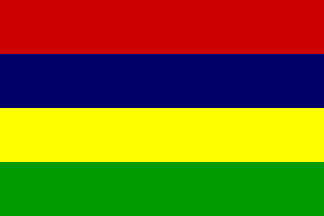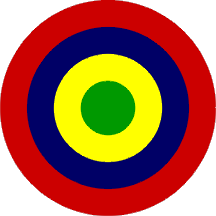 image by Željko Heimer, 13 June 2002
image by Željko Heimer, 13 June 2002
FOTW beschäftigt sich mit der Wissenschaft der Vexillologie (Flaggenkunde).
Alle auf dieser Website dargebotenen Abbildungen dienen ausschließlich der Informationsvermittlung im Sinne der Flaggenkunde.
Wir distanziert uns ausdrücklich von allen hierauf dargestellten Symbolen verfassungsfeindlicher Organisationen.
Last modified: 2023-08-12 by ian macdonald
Keywords: mauritius | dodo | stella clavisque maris indici |
Links: FOTW homepage |
search |
disclaimer and copyright |
write us |
mirrors
 image by Željko Heimer, 13 June 2002
image by Željko Heimer, 13 June 2002
See also:
External links:
The Album 2000 [pay00] says:
1. National Flag and Jack.Four-striped red over blue over yellow over green.2:3
Flag adopted upon independence,
on 9 January
1968.
Phil Nelson, October 2005
On 12 March 1992 Mauritius became republic, but the
independence flag didn’t change.
Jan Zrzavy, 09 October 2002
According to the DK Ultimate Pocket Flags of the World (1997) [rya97], «the flag was designed by the College of Arms in Britain prior to independence and is a simple statement of the colors found in the coat of arms». The same page (110) has also a more bombastic symbolism:
The flag was actually registered at the College of Arms
on 9 January 1968, it was granted by Royal Warrant and the flag first
officially hoisted on 12 March 1968 (the day of independence). However,
whatever the College’s original intention the significance
of the colours are now officially given (although rewritten by myself) as:
The red stripe represents the struggle for freedom and independence, while
blue stands for the Indian Ocean. The yellow stripe symbolizes the new light
of independence, and the green represents agriculture together with the
yearlong colour of a lush country. (I unfortunately cannot find the original
wording.
Christopher Southworth, 08 March 2004
This could easily be interpreted as only minor variants (through
political expediency, perhaps) of the four quarters of the
arms. The red key could be seen as equating to self-determination, as
could the golden settlers’ ships to the search for a new future. The
star over the waters would easily equate to the ocean, as would the sugar
canes to the vegetation.
James Dignan, 08 March 2004
Regardless of accurate matching, is the red shade
supposed to be identical to that on the Union Jack,
i.e., a “dark” shade?
António Martins, 18 September 2008
All the sources I consulted (e.g. [pay00], [smi82], [vdv00]) have these colours in “normal” shades. This particularly goes for the blue, and to less degree (or maybe less obvious) for the red. The shades are not particularly important when looking at the national flag only — but when it comes to ensigns, the questions arise — since these are based on British model, one would expect the shades to be the same as for the Union Jack.
For the red I have not noticed anything
special — it seems that all these sources have the
same red thoughout and I would tend to present it as normal R
(![]() ),
but for the “sameness” with the
“Post Office Red”, R+
(
),
but for the “sameness” with the
“Post Office Red”, R+
(![]() ).
).
The blue is not that simple, here is how blue used in different flags would be coded like this:
| [pay00] | [smi82] | [vdv00] | |
|---|---|---|---|
| National Flag | |||
| CG Ensign | |||
| Civil Ensign | |||
| State Ensign |
* [smi82] shows civil ensign with blue somewhat lighter then normal, but that may be just a printing effect (I think)
So, either the national flag in the state
ensign is indeed different from other variations
(as Smith has it), or the
blue ensign is not that dark as in
British case.
Željko Heimer, 13 June 2002
Dark red (![]() R+) and very (very) dark blue
(
R+) and very (very) dark blue
(![]() B+++),
are based on [pay00] and suggested by
British post colonial “atavism”.
B+++),
are based on [pay00] and suggested by
British post colonial “atavism”.
António Martins, 17 October 2011
These
two
photos show that the shades of the Mauritius’ flag are regular
red and yellow, not dark.
António Martins, 28 April 2010
Pantone codes are shown in the Album des Pavillons Nationaux et des
Marques Distinctives [gcc07]: Red: 186c;
Blue: 294c; Yellow: 123c; Green: 364c.
Bruce Berry, 17 September 2008
Most CMYK/PMS values in [pay00] are
suggested, not official, based in actual cloth matching. Although
they’re probably very accurate concerning real-life use of flag
colors, it is necessary to check the source for each set of flag color
values.
António Martins, 18 September 2008
The Mauritian Standards Bureau is developing a standard for National flag and the flag code. Regarding the colour code for the flag, the BSC codes have been established since a long time and are as follows:
| Colour | BSC |
|---|---|
| Red | 0.005 |
| Blue | 7.806 |
| Yellow | 0.001 |
| Green | 0.010 |
I suppose that this is a standard setting move, with no significant
change on the flag intended.
António Martins, 18 September 2008
Last week I was in Mauritius and attended a meeting of the Mauritius Standards Bureau where they were discussing the flag specifications of the Mauritian flag. The MSB is updating the flag standard to include pantone shades rather than the old British Standard Colour Codes which they had been using previously.
The new pantone equivalents are included in the draft National Flag Standard. There was considerable debate around the shade of red to be adopted as it had been suggested, by a South African flag manufacturer, that Warm Red be used but the Committee finally decided on pantone 1788c instead. The draft now goes for approval and sign-off by the appropriate Minister, following which it will become the new official standard.
Bruce Berry, 16 March 2010
The Mauritian Standards Bureau has issued the following new pantones for the Mauritian national flag:
| Colour | PMS |
|---|---|
| Red | 1788c |
| Blue | 2756c |
| Yellow | 012c |
| Green | 7482c |
The new official yellow, PMS 012c, seems to be closer to
FotW “dark” yellow
(![]() Y+)
than to plain yellow
(
Y+)
than to plain yellow
(![]() Y),
while the new official green, PMS 7482c, is quite light and bluer than any
of our standard shades: a possible equivalent
would be RGB: 0-153-102
(
Y),
while the new official green, PMS 7482c, is quite light and bluer than any
of our standard shades: a possible equivalent
would be RGB: 0-153-102
(![]() ).
).
António Martins, 17 October 2011
Mauritius adopted a National Flag Law. This happened by Act No. 26 of 2015,
which came into force 15 April 2016.
In article 4 the flag is described
as follows:
4. National flag of Mauritius
(1) The national flag of
Mauritius shall –
(a) consist of 4 horizontal stripes of equal width;
(b)
be as set out in Part I of the Schedule;
(c) bear the national colours red,
blue, yellow and green in that order starting from the top and having the
symbolic meaning set out in Part II of the Schedule;
(d) be in the proportion
of 3 horizontally to 2 vertically.
(2) The national flag shall be the symbol
of the Government and the people of Mauritius.
(3) The national flag shall be
for general use in Mauritius and, where appropriate, for international purposes.
Schedule 1 holds an illustration of the colours and dimensions of the
stripes and flag, with the following text:
First Schedule
[Section 4]
Part I – National Flag
[Colour image of the flag including the proportions]
Part II – Symbolic Meaning of the National Colours
1. Red represents the
struggle for freedom and independence.
2. Blue represents the Indian Ocean in
the middle of which Mauritius is situated.
3. Yellow represents the new light
of independence.
4. Green represents the agriculture of Mauritius and its
colour throughout the 12 months of the year.
The whole law was published
in the Legal Supplement to the Government Gazette of Mauritius, No. 111 of 7
November 2015.
Jos Poels, 8 August 2017
The law can be seen at
http://mauritiusassembly.govmu.org/English/acts/Documents/2015/act2615.pdf.
Zachary Harden, 13 August 2017
 image by Željko Heimer, 13 June 2002
image by Željko Heimer, 13 June 2002
Roundel of the national colours.
[pay00]
Željko Heimer, 13 June 2002
Mauritius Coast Guard operated three planes and use the roundel as
above.
Dov Gutterman, 20 June 2004
 image by Vincent Morley and Dov Gutterman, 10 February 2000
image by Vincent Morley and Dov Gutterman, 10 February 2000
Mauritius’ planes carries a 1:1 version of the national flag.
Dov Gutterman, 10 February 2000
Mauritius Coast Guard operated three planes and use the national
flag as fin flash. The book [cos98]
shows the fin flash in square form, but a
photo
on line shows a regular flag.
Dov Gutterman, 20 June 2004
The national flag is painted on the fin, says Album
2000 [pay00]
Željko Heimer, 13 June 2002
.gif) image by Željko Heimer, 13 June 2002
image by Željko Heimer, 13 June 2002
The coat of arms of Mauritius is described as follows in Dorling-Kindersley Pocket-Book [rya97]:
The coat of arms was granted on 25 August 1906, and depicts various attributes of the island. In the lower right quarter is a key and on the left-hand side is a white star, which are referred to in the Latin motto "Stella Clavisque Maris Indici" ("The Star and the Key of the Indian Ocean"). The supporters are a dodo and a deer each holding a sugar cane, the island’s staple crop.The caption of the image in the same source gives additional details:
The motto on the scroll reads "STELLA CLAVISQUE MARIS
INDICI" ("Star and key of the Indian sea").
Vincent Morley, 03 March 1997
In some sources the star is shown voided. According to Album 2000
[pay00] this is wrong.
Željko Heimer, 13 June 2002
The existence of a Mauritian Telugu flag may imply
the existence of flags for other Mauritian minorities, of which there are
plenty…
António Martins, 07 November 2007
See also:
I just found a (to me) intriguing comment on a
Telugu
website, where it says that Mauritius «is the only country where
Telugus have a distinct National Telugu flag which symbolizes Telugu culture
and Mauritian nationalism with the famous Om karam in Telugu.»
Lê Thanh-Tâm, 16 March 2007
This would be something like
"ఓమ్" (long vowel "o", letter "ma", and
virama), which is not particularly flaggish, I should say.
Unicode has specific precomposed characters for the "om" syllable
(Devanagari "ॐ", Tibetan "ༀ", Gujarati "ૐ", Tamil
"ௐ", plus the unrelated Bopomofo "ㆱ" and Korean "옴"),
but no specific precomposed character for Telugu "om":
Perhaps this is about the well known Devanagari
"om" sign, regardless of the fact that Telugus use a different
script in normal affairs, just like the "chi-rho" monogram become
popular among non-Greek Christians?
António Martins, 07 November 2007
A coworker just returned from Port-Louis
reported no beach flags for bathers’ safety
but yes a “traffic light” flag system for wind
conditions.
António Martins, 10 October 2007
Hosted by: Fanshop-Online.de und Handy-Shop.de
Tipp: Apple iPhone 15 im Shop